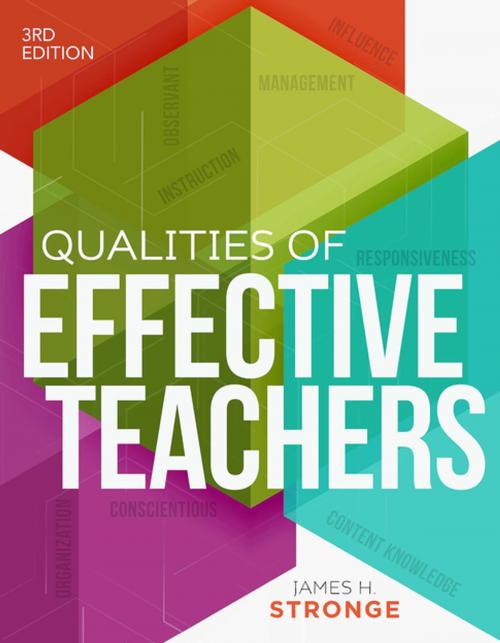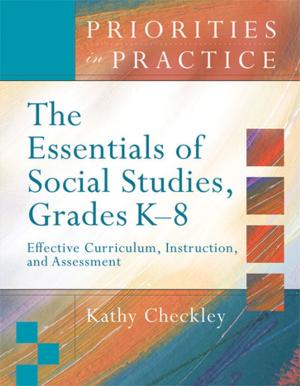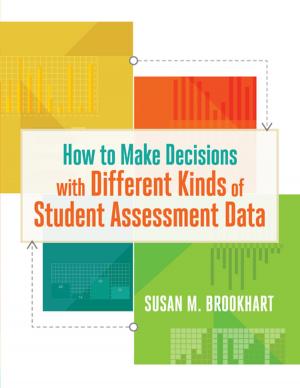| Author: | James H. Stronge | ISBN: | 9781416625896 |
| Publisher: | ASCD | Publication: | March 21, 2018 |
| Imprint: | ASCD | Language: | English |
| Author: | James H. Stronge |
| ISBN: | 9781416625896 |
| Publisher: | ASCD |
| Publication: | March 21, 2018 |
| Imprint: | ASCD |
| Language: | English |
Every teacher seeks to be an effective teacher. Every teacher wants to have a positive, remarkable, and lasting influence on students' lives.
But what makes for an effective teacher? What role does teacher preparation play in teacher effectiveness? What do effective teachers do during planning, instruction, and assessment? How do they create a learning environment that engages and supports students? And how do effective teachers interact with their students to promote the best opportunities and results for all?
In Qualities of Effective Teachers, 3rd edition, James H. Stronge explores these questions and more as he synthesizes the literature on teacher effectiveness. The result? A research-based framework for effective teaching that addresses:
- Professional knowledge
- Instructional planning
- Instructional delivery
- Assessment
- Learning environment
- Professionalism
Stronge also examines characteristics of effective teachers of at-risk students and high-ability students. To bridge the gap between research and practice, he includes checklists of skills and positive qualities associated with effective teacher performance as well as red flags that indicate that teachers may not be reaching their full potential in the classroom.
This resource is for any educator interested in improving teaching. It offers research-based advice for teachers who wish to improve their own performance, as well guidance for teacher leaders and supervisors, school administrators and department heads, staff development specialists, teacher and administrator educators, human resource specialists, and education policymakers and their staffs. Anyone who has a vested interest in students and their success can gain valuable insight and practical tools to ensure positive outcomes for all students.
New to the 3rd edition:
- Introduction of the Framework for Effective Teaching and its six domains—professional knowledge; instructional planning; instructional delivery; assessment; learning environment; professionalism
- Chapter vignettes updated to illustrate the domains of the Framework for Effective Teaching
- Updated reference charts at the end of chapters, keyed to the subdomains of the Framework for Effective Teaching and expanded to include references for 21 century teachers
- Twenty-nine sidebars interspersed throughout chapters that provide state-of-the-art supplementary text on effective teaching practices and research findings
- Updated Teacher Skills Assessment Checklist, keyed to the domains of the Framework for Effective Teaching
- Updated Part 2 presents positive qualities and red flags associated with effective teachers, keyed to the domains of the Framework for Effective Teaching
- More than 1,000 entries in the References
Every teacher seeks to be an effective teacher. Every teacher wants to have a positive, remarkable, and lasting influence on students' lives.
But what makes for an effective teacher? What role does teacher preparation play in teacher effectiveness? What do effective teachers do during planning, instruction, and assessment? How do they create a learning environment that engages and supports students? And how do effective teachers interact with their students to promote the best opportunities and results for all?
In Qualities of Effective Teachers, 3rd edition, James H. Stronge explores these questions and more as he synthesizes the literature on teacher effectiveness. The result? A research-based framework for effective teaching that addresses:
- Professional knowledge
- Instructional planning
- Instructional delivery
- Assessment
- Learning environment
- Professionalism
Stronge also examines characteristics of effective teachers of at-risk students and high-ability students. To bridge the gap between research and practice, he includes checklists of skills and positive qualities associated with effective teacher performance as well as red flags that indicate that teachers may not be reaching their full potential in the classroom.
This resource is for any educator interested in improving teaching. It offers research-based advice for teachers who wish to improve their own performance, as well guidance for teacher leaders and supervisors, school administrators and department heads, staff development specialists, teacher and administrator educators, human resource specialists, and education policymakers and their staffs. Anyone who has a vested interest in students and their success can gain valuable insight and practical tools to ensure positive outcomes for all students.
New to the 3rd edition:
- Introduction of the Framework for Effective Teaching and its six domains—professional knowledge; instructional planning; instructional delivery; assessment; learning environment; professionalism
- Chapter vignettes updated to illustrate the domains of the Framework for Effective Teaching
- Updated reference charts at the end of chapters, keyed to the subdomains of the Framework for Effective Teaching and expanded to include references for 21 century teachers
- Twenty-nine sidebars interspersed throughout chapters that provide state-of-the-art supplementary text on effective teaching practices and research findings
- Updated Teacher Skills Assessment Checklist, keyed to the domains of the Framework for Effective Teaching
- Updated Part 2 presents positive qualities and red flags associated with effective teachers, keyed to the domains of the Framework for Effective Teaching
- More than 1,000 entries in the References















